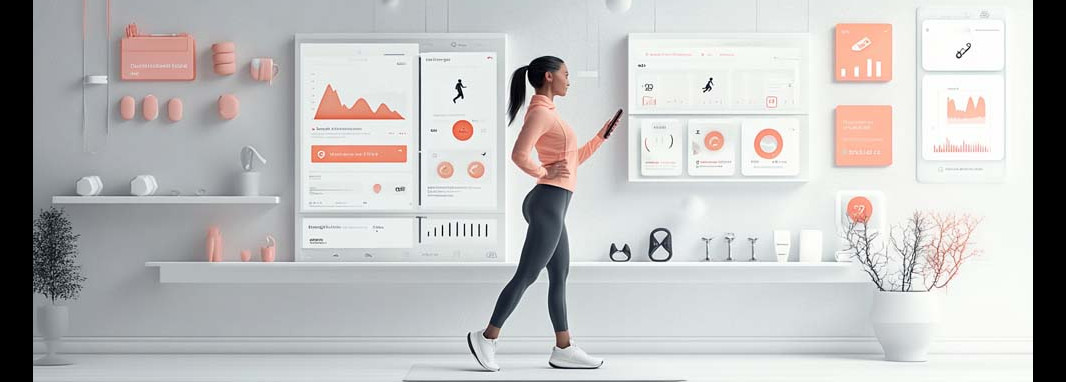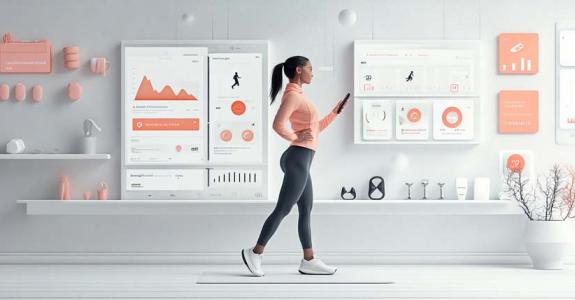Define Your Target Audience for Fitness App
Before developing a fitness app, it's crucial to clearly identify who it is intended for.
This impacts not only functionality but also marketing strategy, design, and monetization methods.
1. 🎯 Primary Goals
Most users aim to lose weight, gain muscle, improve endurance, or maintain their fitness. Here’s a more detailed breakdown of their goals:
- 🔥 Weight Loss – Users need effective fat-burning workouts, meal tracking, and motivation.
Features like 30-day challenges, workout reminders, and progress tracking can be highly engaging.
- 💪 Muscle Gain – Strength training programs, progressive overload tracking, and nutritional support are essential.
These users will benefit from integration with fitness trackers and protein intake recommendations.
- ⚡ Maintaining Fitness – People with this goal seek convenient workout plans without strict regimens, such as quick yet effective 10-20 minute routines.
- 🏃 Endurance Training – Runners, cyclists, and functional training enthusiasts need GPS tracking, cardiovascular analytics, and structured progressive workout plans.
- 🧘 Flexibility & Relaxation – Yoga, stretching, and breathing exercises are key. These users often look for video tutorials and reminders for regular sessions.
2. 📍 Where and How Do Users Work Out?
The workout environment determines what features an app should offer:
- 🏋️ At the Gym – These users need structured workout plans, progress tracking, and exercise technique guides.
- 🏠 At Home – They prefer workouts without equipment, flexible schedules, timers, and video instructions.
- 👨🏫 With a Personal Trainer – Require built-in messaging, adjustable workout plans, and training logs.
- 🌳 Outdoors – Need GPS tracking, route mapping, and wearable device synchronization.
An app can either target one specific group or cater to multiple workout styles.
3. 👥 Gender and Training Preferences
Although men and women often share the same fitness goals, their motivations, workout styles, and app expectationscan vary:
- 🦾 Men – Tend to focus on muscle building, strength improvement, and functional training.
- 💃 Women – Often prioritize body toning, yoga, cardio, and bodyweight exercises.
- 🔄 Universal Approach – The most successful apps allow users to set their fitness goals and receive workout recommendations tailored to their preferences.
4. 🎂 Age Groups
Fitness goals and app engagement vary across different age groups:
- 👶 18-25 years old – Motivated by social trends, challenges, and group workouts.
Gamification, leaderboards, and competitive elements work well.
- 👨💼 25-40 years old – Balance fitness with work and family life, seeking efficiency.
Short, high-impact workouts are popular.
- 👴 40-55 years old – Prioritize health, functional fitness, and injury prevention.
Sustainable, safe workout programs are key.
- 🦽 55+ years old – Prefer low-intensity exercises, joint-friendly workouts, and posture correction routines.
5. 📊 Fitness Levels
Users of different fitness levels require different app functionalities:
- 🟢 Beginners – Need easy-to-follow instructions, voice guidance, and step-by-step workout plans.
The app should help build consistency.
- 🟠 Intermediate Users – Seek more structured programs, customization options, and detailed progress tracking.
- 🔴 Advanced Users – Require analytics, wearable device integration, progressive overload tracking, and in-depth performance insights.
🏆 Conclusion on
Building a successful fitness app starts with understanding your target audience. The more tailored your app is to user needs, the higher the engagement and long-term success.
Choose the Right Type of Fitness App
Before developing your app, it's essential to determine what problem it will solve. The fitness market includes several key categories, each with its own audience and unique features.
1. Workout Apps
💪 Focus: Pre-made workout programs and personalized plans.
📌 Examples: Nike Training Club, Freeletics.
👥 Audience: Home and gym users, beginners, and advanced fitness enthusiasts.
🔹 Key Features:
- Exercise library with video tutorials.
- Personalized or automated workout plans.
- Timers, progress tracking, and reminders.
✅ Best for:Creating an app that helps users structure their workouts and improve their fitness.
2. Nutrition & Diet Apps
🥗 Focus: Calorie tracking, meal planning, and nutrition monitoring.
📌 Examples: MyFitnessPal, Lifesum.
👥 Audience: People looking to lose weight, gain muscle, or improve their eating habits.
🔹 Key Features:
- Food database with calorie and macronutrient information.
- Barcode scanner for easy meal logging.
- Automated daily intake recommendations.
✅ Best for:Helping users stay on top of their diet and reach their fitness goals through mindful eating.
3. Activity Tracking Apps
🏃 Focus: Monitoring steps, calories, sleep, and physical activity.
📌 Examples: Strava, Google Fit, Apple Health.
👥 Audience: Runners, cyclists, walkers, and anyone tracking daily movement.
🔹 Key Features:
- Integration with wearables (smartwatches, fitness bands).
- GPS tracking, step counting, heart rate monitoring.
- Activity stats, progress reports, and goal setting.
✅ Best for:Encouraging users to stay active by tracking their movement and progress.
4. Yoga & Meditation Apps
🧘 Focus: Flexibility exercises, breathing techniques, and relaxation.
📌 Examples: Calm, Headspace, Glo.
👥 Audience: Users looking to balance physical and mental health, interested in meditation and recovery.
🔹 Key Features:
- Video lessons and guided audio sessions.
- Adjustable programs for different skill levels.
- Meditation timers, nature sounds, and breathing exercises.
✅ Best for:Developing an app that promotes mindfulness, relaxation, and overall well-being.
5. Personal Training Apps
🏋️♂️ Focus: Connecting trainers with clients, custom workout plans, and progress tracking.
📌 Examples: Trainerize, My PT Hub.
👥 Audience: Personal trainers, fitness studios, and clients needing customized guidance.
🔹 Key Features:
- Video exercise demonstrations and messaging with trainers.
- Personalized workout and nutrition plans.
- Progress tracking and reporting systems.
✅ Best for:Building a platform that enhances trainer-client interaction and program customization.
Which Type Should You Choose?
The right choice depends on your target audience and business goals.
You can develop a hybrid app that combines multiple categories (e.g., workouts + nutrition) or focus on a specialized niche to provide unique solutions for a specific group of users.
If you're unsure which type of fitness app best suits your business model, check out our guide on How to Choose the Right Fitness App Type for Your Business?
Define Core Features of Your Fitness App
To build a successful fitness app, you need to include core features that match user expectations and support their goals.
These features shape the user experience, impact engagement, and define the value of your product.
Here are the must-have features to consider:
👤 User Profiles
Allow users to personalize their experience:
- Basic info: age, gender, fitness level, goals.
- Workout history and progress tracking.
- Saved workouts, preferences, and achievements.
✅ Why it matters:Personalization increases engagement and relevance.
📅 Workout Plans
Offer both pre-built and customizable workout programs:
- Programs based on goals (weight loss, muscle gain, etc.).
- Weekly schedules with adjustable intensity.
- Video tutorials, progress indicators, and reminders.
✅ Why it matters:Structured plans help users stay consistent and motivated.
📈 Activity Tracking
Monitor fitness progress through real data:
- Steps, calories burned, workout duration.
- Heart rate, distance, reps (if synced with wearables).
- Daily, weekly, and monthly summaries.
✅ Why it matters:Data-driven feedback builds trust and keeps users accountable.
🎮 Gamification
Add elements of play to boost motivation:
- Achievements and badges.
- Daily/weekly challenges.
- Leaderboards and goal streaks.
✅ Why it matters:Gamification improves user retention and encourages habit formation.
💬 Social Features
Help users connect, share, and stay motivated together:
- Chat, comment sections, community groups.
- Progress sharing and team challenges.
- Trainer-client communication tools.
✅ Why it matters:Social engagement fosters accountability and community.
⌚ Wearable Integration
Connect the app with fitness devices for real-time data:
- Apple Watch, Fitbit, Garmin, etc.
- Sync heart rate, steps, sleep, and workout data.
- Enable automatic activity recognition.
✅ Why it matters:Integration adds value and accuracy to user insights.
💳 Payments & Subscriptions
Offer flexible monetization options:
- Free access with optional premium upgrade.
- Monthly/annual subscription plans.
- In-app purchases for content or coaching.
✅ Why it matters:A clear and valuable pricing model supports scalability and revenue growth.
🚀 Final Thought
These features are not just technical tools — they directly impact user satisfaction, motivation, and retention.
Start with the essentials, and expand based on your audience’s needs and feedback.
💰Choose a Monetization Strategy
Your monetization model should align with your target audience’s expectations and willingness to pay.
A clear and sustainable revenue strategy not only helps you scale but also shapes the product experience.
Here are the most common monetization options for fitness apps:
1. 🆓 Freemium + In-App Purchases
Offer a free basic version with the option to unlock advanced features or content.
- Example: Free workouts + premium programs or nutrition plans.
- Users pay for what they value most.
✅ Best for:Attracting a wide user base while gradually converting free users into paying customers.
2. 📅 Subscriptions (Monthly/Yearly)
Provide full access to all features under a recurring payment model.
- Tiers: Basic, Pro, or Premium.
- Include trials, discounts, or bundle offers.
✅ Best for:Apps offering ongoing value, such as evolving workout plans, coaching, or weekly updates.
3. 💵 One-Time Purchase
Users pay once to access the full app.
- No recurring payments, no locked content.
- Simple model, but limited long-term revenue.
✅ Best for:Apps with a static set of features or a clear, finite value proposition.
4. 📢 Ads & Partnerships
Earn revenue through brand sponsorships, ads, or affiliate marketing.
- Partner with fitness brands, gyms, or wellness products.
- Rewarded ads can offer in-app bonuses.
✅ Best for:Free apps with high traffic and strong engagement.
💡 Tip:
Many successful apps combine multiple models— for example, freemium + subscription + branded content.
Choose what matches your user base and long-term vision.
Want help selecting the right revenue model for your product?
Stay tuned for our article on how to choose the best monetization strategy for your fitness app.
🎨 Create an Intuitive and Engaging Design
Design plays a critical role in how users interact with your app, stay motivated, and keep coming back.
A great fitness app isn’t just functional — it should be enjoyable and effortless to use.
Here are the three key principles to follow:
1. 🧭 Simple and Intuitive Navigation
- Clear layout with minimal steps to start a workout or view progress.
- Logical menu structure and easily accessible key features.
- Fast onboarding with helpful prompts or guided setup.
✅ Why it matters:Users won’t stay long in an app that feels confusing or overwhelming.
2. 👁️ Visually Appealing Interface
- Clean, motivational design with bold visuals and encouraging colors.
- High-quality images or animations for exercises.
- Smooth transitions and responsive interactions.
✅ Why it matters:Aesthetic appeal creates a sense of trust and motivates regular use.
3. 🧠 Personalization & Smart Suggestions
- Custom workout and nutrition recommendations based on user goals.
- Adaptive content (e.g., “recommended for you,” “resume your last session”).
- Progress-based interface that evolves with the user.
✅ Why it matters:Personalization increases relevance and keeps users engaged longer.
A well-designed fitness app should feel like a coach, not just a tool— intuitive, encouraging, and tailored to each user’s journey.
📌 Want to Dive Deeper?
Design isn’t just about how your app looks — it’s about how it works for real people with real goals. If you're planning to create a fitness app that people actually want to use, don’t miss our upcoming article:
"How to Design a Fitness App: UX/UI Best Practices for Engagement and Retention"
📣 Attract Your First Users
Launching a fitness app is only half the battle — the real challenge is getting people to discover and try it. A strong marketing strategy is essential in the early stages to build momentum and gather feedback.
Here are proven ways to reach your first audience:
1. 🔍 App Store Optimization (ASO)
- Optimize your app title, description, keywords, and visuals for the App Store and Google Play.
- Use clear screenshots, demo videos, and strong CTA text.
- Collect early reviews to build trust and visibility.
✅ Why it matters:Most users discover apps through search — ASO improves organic reach.
2. 🤳 Influencer Marketing & Ads
- Partner with fitness influencers on TikTok, Instagram, or YouTube.
- Use paid ads targeting interests like health, wellness, or specific goals (e.g., weight loss).
- Share transformation stories and real user experiences.
✅ Why it matters:People trust people — social proof drives downloads.
3. 🏆 Challenges & Contests
- Create 7-day or 30-day fitness challenges.
- Offer rewards for progress, sharing, or inviting friends.
- Encourage user-generated content with hashtags.
✅ Why it matters:Interactive content drives virality and community engagement.
4. 📱 Social Media & Content Marketing
- Build presence on platforms like Instagram, Pinterest, and LinkedIn.
- Share tips, quick workouts, behind-the-scenes updates, and user success stories.
- Start a blog or YouTube channel to provide value and boost SEO.
✅ Why it matters:Consistent content builds your brand and keeps users connected.
💡 Want to Learn More?
We’re preparing a full article on this topic:
"How to Promote a Fitness App: Strategies to Get Your First 10,000 Users"
There, we’ll break down real examples, budget tips, and step-by-step tactics to grow your user base fast. Stay tuned!
🔄 Support and Grow Your Fitness App
Launching is just the beginning — successful apps are those that evolve based on real user feedback and behavior. Ongoing support and improvement turn first-time users into long-term fans.
Here’s what to focus on after release:
1. 🗣️ Gather Feedback
- Monitor app reviews, support emails, and social media comments.
- Ask for feedback directly in-app (e.g., short surveys, NPS prompts).
- Identify recurring issues or feature requests.
✅ Why it matters:User insights guide smart decisions and help you prioritize what really matters.
2. 🔧 Update Features Regularly
- Fix bugs and optimize performance.
- Add new workouts, challenges, or integrations based on demand.
- Roll out seasonal content (e.g., summer body plans, New Year resets).
✅ Why it matters:Regular updates show users the app is active and evolving.
3. 📊 Analyze User Behavior
- Use analytics to track retention, drop-off points, and feature usage.
- A/B test onboarding flows, buttons, or pricing models.
- Spot patterns: which features keep users coming back?
✅ Why it matters:Data helps you improve UX and make the app more effective.
🚀 Bonus Tip
Retention is more important than downloads. Apps that continue to listen, improve, and adaptare the ones that win in the long run.
We’ll explore this in depth in our upcoming article:
"Post-Launch Strategy for Fitness Apps: How to Retain and Grow Your User Base"— don’t miss it if you're planning long-term success.
✅ Summary: From Idea to Execution
Building a successful fitness app isn’t about luck — it’s about strategy. From identifying your audience and choosing the right app type to designing core features, monetization, and marketing, each step plays a role in long-term success.
Whether you're targeting weight loss, strength, or mindfulness users, focus on solving real problems with intuitive, personalized experiences.
Want to go deeper? Explore our related guides on:
- How to Define the Target Audience for Your Fitness App
- How Much Does It Cost to Develop a Fitness App?
- Must-Have Features for a Successful Fitness App
- How to Promote a Fitness App: Get Your First 10,000 Users
- Post-Launch Strategy for Fitness Apps
Your fitness app journey starts here — and we’re here to help you scale it.






